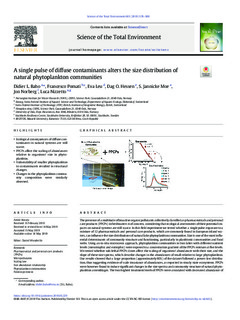| dc.contributor.author | Baho, Didier Ludovic | |
| dc.contributor.author | Pomati, Francesco | |
| dc.contributor.author | Leu, Eva | |
| dc.contributor.author | Hessen, Dag Olav | |
| dc.contributor.author | Moe, S. Jannicke | |
| dc.contributor.author | Norberg, Jon | |
| dc.contributor.author | Nizzetto, Luca | |
| dc.date.accessioned | 2019-10-08T08:06:02Z | |
| dc.date.available | 2019-10-08T08:06:02Z | |
| dc.date.created | 2019-07-02T13:54:37Z | |
| dc.date.issued | 2019 | |
| dc.identifier.citation | Science of the Total Environment. 2019, 683, 578-588. | nb_NO |
| dc.identifier.issn | 0048-9697 | |
| dc.identifier.uri | http://hdl.handle.net/11250/2620762 | |
| dc.description.abstract | The presence of a multitude of bioactive organic pollutants collectively classified as pharmaceuticals and personal care products (PPCPs) in freshwaters is of concern, considering that ecological assessments of their potential impacts on natural systems are still scarce. In this field experiment we tested whether a single pulse exposure to a mixture of 12 pharmaceuticals and personal care products, which are commonly found in European inland waters, can influence the size distributions of natural lake phytoplankton communities. Size is one of the most influential determinants of community structure and functioning, particularly in planktonic communities and food webs. Using an in-situ microcosm approach, phytoplankton communities in two lakes with different nutrient levels (mesotrophic and eutrophic) were exposed to a concentration gradient of the PPCPs mixture at five levels. We tested whether sub-lethal PPCPs doses affect the scaling of organisms' abundances with their size, and the slope of these size spectra, which describe changes in the abundances of small relative to large phytoplankton. Our results showed that a large proportion (approximately 80%) of the dataset followed a power-law distribution, thus suggesting evidence of scale invariance of abundances, as expected in steady state ecosystems. PPCPs were however found to induce significant changes in the size spectra and community structure of natural phytoplankton assemblages. The two highest treatment levels of PPCPs were associated with decreased abundance of the most dominant size class (nano-phytoplankton: 2–5 μm), leading to a flattening of the size spectra slope. These results suggest that a pulse exposure to PPCPs induce changes that potentially lead to unsteady ecosystem states and cascading effects in the aquatic food webs, by favoring larger non-edible algae at the expense of small edible species. We propose higher susceptibility due to higher surface to volume ratio in small species as the likely cause of these structural changes. | nb_NO |
| dc.language.iso | eng | nb_NO |
| dc.publisher | Elsevier | nb_NO |
| dc.rights | Attribution-NonCommercial-NoDerivatives 4.0 Internasjonal | * |
| dc.rights.uri | http://creativecommons.org/licenses/by-nc-nd/4.0/deed.no | * |
| dc.title | A single pulse of diffuse contaminants alters the size distribution of natural phytoplankton communities | nb_NO |
| dc.type | Journal article | nb_NO |
| dc.type | Peer reviewed | nb_NO |
| dc.description.version | publishedVersion | nb_NO |
| dc.rights.holder | © 2019 The Authors | nb_NO |
| dc.source.pagenumber | 578-588 | nb_NO |
| dc.source.volume | 683 | nb_NO |
| dc.source.journal | Science of the Total Environment | nb_NO |
| dc.identifier.doi | 10.1016/j.scitotenv.2019.05.229 | |
| dc.identifier.cristin | 1709431 | |
| dc.relation.project | Norges forskningsråd: 244460 | nb_NO |
| cristin.unitcode | 7464,30,21,0 | |
| cristin.unitcode | 7464,20,13,0 | |
| cristin.unitname | Miljøkjemi | |
| cristin.unitname | Økotoksikologi | |
| cristin.ispublished | true | |
| cristin.fulltext | original | |
| cristin.qualitycode | 2 | |

